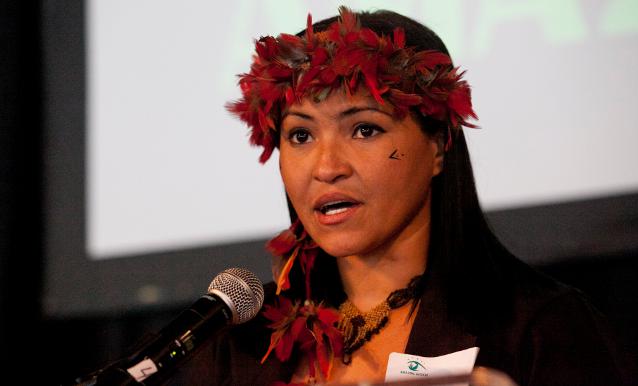
Sheyla Juruna
Indigenous people are trying to liberate the Americas, and they are led by women. In Brazil yesterday, hundreds of indigenous leaders, fisherfolk and others from the Xingu River basin gathered to occupy the Belo Monte Dam construction site in a peaceful protest to stop its construction in the heart of the Brazilian Amazon. Belo Monte is one of those mega-dams that cost billions of dollars, displace whole communities, wipe out acres and acres of forest, all in the name of “necessary energy production.”
Ealier this week, the Inter-American Commission on Human Rights tried to create a space for the indigenous communities, and their supporters, and the Brazilian government to enter into dialogue. The Juruna people sent their leader, Sheyla Juruna, who travelled days to get to Washington. The much wealthier, much more popular, and much better resourced Brazilian government sent … no one.
And so indigenous communities of the Xingu, and their supporters, took to the dam site, and they were, and are, led by women. Sheyla Juruna. Juma Xipaia. Roberta Amanajás. Antonia Melo. Some, like Juruna and Xiapaia, are indigenous leaders. Some, like Amanajás, are human rights advocates and activists. Some, like Melo, are leaders of movements, in this instance the Xingu Forever Alive Movement.
Cherokee feminist activist and author Andrea Smith once wrote, “The primary reason for the continuing genocide of Native peoples has less to do with ignorance and more to do with material conditions. Non-Indians continue to oppress Indians because Indians occupy land resources that the dominant society wants.”
The indigenous women leaders and communities of the Xingu River basin know, and live, this history today. They know the genocide takes many forms. Sometimes it’s flat out extermination campaigns. At other times, it’s removal, person by person, nation by nation, child by child.
In the United States, for example, a Federal law states that if Native American children are taken from their homes, they must be placed with their family members, relatives, their tribes or other Native Americans. And native children are taken from their homes, at a much higher rate than children of other races and communities. Some studies suggest the rate is twice as high. Furthermore, of the native children taken from their homes, a remarkably low percentage have experienced sexual or physical abuse. So, why are they taken? “For their own good” … of course.
A report this week highlighted the situation of these stolen children in South Dakota. Nearly 90 percent are placed in non-Native households or group settings. Those non-native group settings are private, and making good profit off of the “poor” native children.
Who cares? Well, the children care. Their families care. Their communities care. And while the caring of the children isn’t particularly gendered, the caring by the adults is. Women. Women like Janice Howe, a grandmother who refused to let the State get away with kidnapping, who fought for over a year and a half to get her grandkids back. Four children, including Antoinette, 6 years old, and Raushana, 5 years old. When they returned, 18 months later, they were each a full dress size smaller. Only now are the stories of their sojourn beginning to emerge.
There are native Grandmothers’ Groups, native foster home providers, native foster parents, tribal social workers, and they are everywhere on the reservation. There are also mothers who mourn and wait and, if they’re very “lucky”, may, just may some day meet their children. In the case of Dwayne Stenstrom, kidnapped by the State at the age of 8 years old, this reunion occurred decades later … six months before his mother died of cancer.
And no one ever receives an apology, ever receives an acknowledgment. This is what military occupation looks like.
As the Occupy Wall Street movement has spread, or effloresced, across the United States and Canada, indigenous people across both countries have criticized the term “occupation”. Some have suggested replacing it with “decolonize” or “(un)occupy”, others have noted the painful nationalism and racism of their supposed, or potential, allies in the current movement.
And others have said, instead, “Defend Mother Earth.” At the Belo Monte Dam site yesterday, Juma Xipaia explained, “We will not be silent. We will shout out loud and we will do it now.” The Mothers, Grandmothers, Daughters, Sisters, Aunts, Women are gathering, out loud, now, to Defend Mother Earth. Another occupation is possible. Shout out loud, do it now.
(Photo Credit: Amazon Watch)